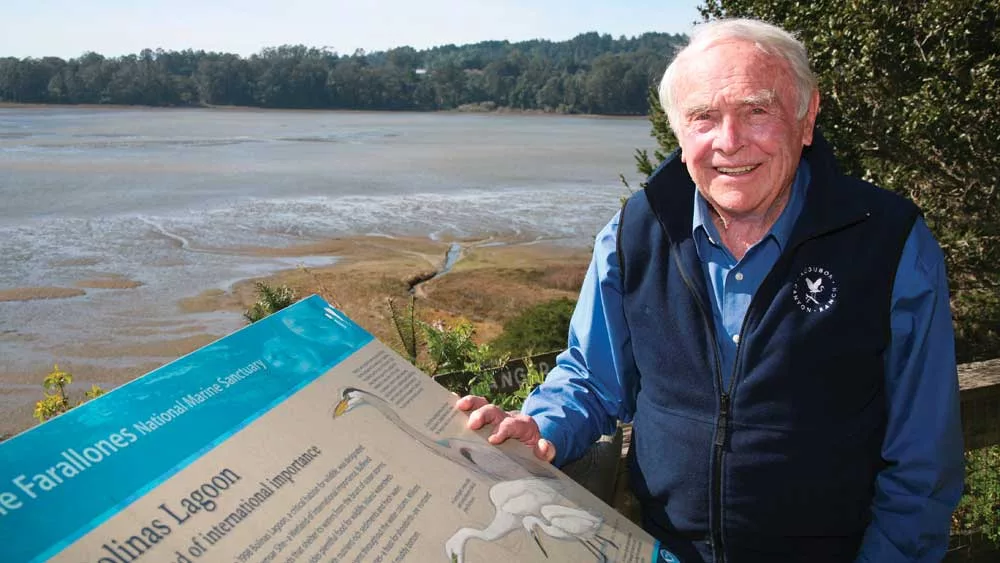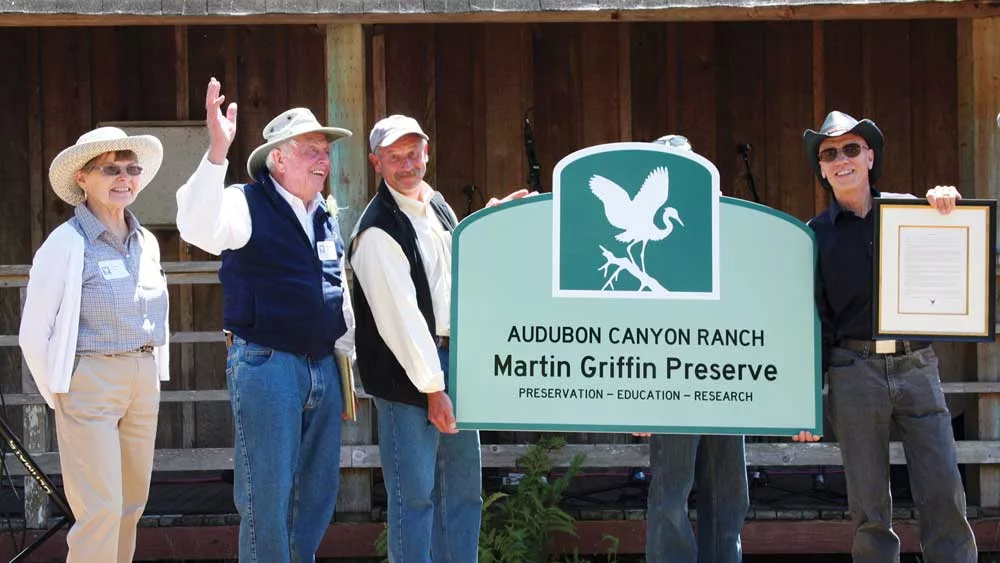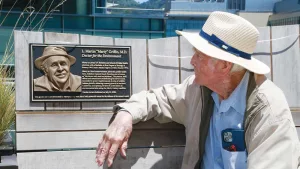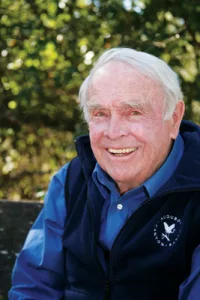
When Dr. Loyal Martin Griffin marked his 103rd birthday in July, he had plenty to celebrate. As a respected environmentalist, he’s accrued a long list of accomplishments that have helped shape the North Bay coast, and he continues to learn about environmental issues and share his wisdom with others who have similar concerns.
Griffin—known as Marty—was born in Utah on July 23, 1920, and his first memories are infused with the sights and sound of nature. His family moved west during the Great Depression and finally settled in Oakland, where he became a Boy Scout, earning the rank of Eagle Scout. Scouting gave him an opportunity to visit Marin County and experience its natural environment.
“When I was in high school, I came over quite a bit to see the birds,” he says about his early treks to Marin. That was the beginning of a love for the wildlife and natural environment of West Marin’s coastal areas that prompted his activism years later.
He graduated from Stanford Medical School in 1946 and earned certification as a diplomate of the American Board of Internal Medicine in 1953. He practiced in Marin County for 17 years and helped start the Ross Valley Clinic, Ross General Hospital, Kentfield Psychiatric Hospital and The Tamalpais, a retirement center in Greenbrae. The years he was building a successful medical practice coincided with the construction boom that followed World War II, and in the mid-1950s, he learned about a plan for the development of Richardson Bay, a stopover on the Pacific Flyway for migrating waterfowl. That was the defining moment that put him on the path to environmental activism.
If you can’t beat ‘em, buy ‘em!

The idea was to level five acres of Ring Mountain, which separates Tiburon and East Corte Madera, and use the bulldozed material to fill 800 acres of Richardson Bay, which would allow the building of 2,000 houses and a marina in a planned community called Reedport. Appalled at the notion, he joined forces with Caroline Livermore and David Steinhardt, who had established the Richardson Bay Foundation, to stop the development. They decided that the best strategy was to quietly buy the maritime acreage and, little by little, they acquired the properties they needed. In 1958, they arranged for Marin County to purchase 700 acres of Richardson Bay and the City of Belvedere to buy another 200. Then they created the Marin Audubon Society so they could enlist the help of the National Audubon Society, which agreed to lease all 900 acres to create what is known today as the Richardson Bay Audubon Center & Sanctuary.
Rosie Verrall (1883-1964), a longtime tenant farmer—known as the Tiburon Goat Lady due to her many ruminant companions—had inherited 11 acres of property from landowner John Reed on the Richardson Bay shoreline adjacent to the sanctuary, and she’d sold four, but Livermore convinced her to deed the remaining seven to the Marin Conservation League. Part of the deal involved providing her with a personal physician, and Griffin agreed to tend to her medical needs and gained a reputation as the Goat Lady’s doctor. He was concerned, however, about the risk of development on the four acres she’d sold, and traveled to Chicago to visit the owner of the parcel, Harry Marshall, and persuaded him to donate the land to the National Audubon Society. The site is now home to the Richardson Bay Audubon Center, which has over the decades welcomed countless nature lovers and children on field trips to explore the magnificent grounds. With clever tactics and determination, Griffin and his colleagues won the fight to preserve Richardson Bay, and also adopted valuable tactics for opposing development in the bigger battles ahead.
“I learned that you didn’t have to fight these people directly. You could outsmart them,” he says.
Alarming developments
At the end of the 1950s, then-California Gov. Pat Brown, who served from 1959 to 1967, was planning to make good on his campaign promise to build 1,000 miles of freeways and construct dams on rivers throughout Northern California. Among his plans were a four-lane coastal highway along the Marin and Sonoma coast and a parkway across Marin County to connect West Marin and the Richmond-San Rafael Bridge.
He also envisioned establishing eight new cities, including one in the Marin Headlands, another on the Point Reyes Peninsula, as well as Sea Ranch on the Sonoma-Mendocino border. A developer bought a large part of Bolinas Ridge on the mountain’s west slope, while the State Lands Commission leased 1,200 acres of Bolinas Lagoon to a developer, who planned to build a high-rise office building on Kent Island, dredge the lagoon and construct a marina with a turnaround for motorboats.
Griffin was alarmed. A colony of herons inhabited part of the lagoon, and he was interested in saving birds and bird habitats. “Our heronry would have been ruined,” he told NorthBay biz recently. And so he and a group of like-minded people who were strongly opposed to destroying the lagoon’s natural environment embarked on a campaign of strategic purchases. They acquired property and water and, at one point, Griffin wrote a personal check for $1,000 to hold Canyon Ranch, a property on the Bolinas Lagoon shoreline that was up for sale for $337,000. He didn’t know if they could raise the money to complete the purchase but, in retrospect, he believes that signing the contract to buy the 500-acre property was a wise decision. “It was a lot of money at the time,” he says, but he realized it was important, so he took a chance rather than miss the opportunity. “Abraham Lincoln said that public sentiment is everything. If you don’t have the public behind you can’t do anything,” he says.

Meanwhile, developers were targeting Tomales Bay and the Marin Headlands. Thomas Frouge, a developer from Connecticut had bought 2,138 acres of the headlands with a vision for a planned community of more than 20,000 residents, who would live in apartment towers, houses and townhouses. In 1965, Marin County approved plans for the development—dubbed Marincello—and contractors began work to build a road and a gated entrance to the property in Tennessee Valley. Griffin joined locals Huey Johnson, Douglas Ferguson and Martin Rosen, who founded The Trust for Public Land, and they launched a campaign to block development. With leadership from Kentfield resident Roger Kent, chairman of the state Democratic Party, Griffin and fellow activists took political action to replace Ernest Kettenhofen, a key voice on the Marin County Board of Supervisors, who was in favor of the development of West Marin. Their chosen candidate was Peter Arrigoni, a former mayor of Fairfax, who won the seat and went on to serve from 1968 to 1976—and in 1970 was instrumental in reversing the board’s previous approval of Marincello. The following year, with Arrigoni as a swing vote, the supervisors also repealed the West Marin General Plan, saving Tomales Bay from development. The Nature Conservancy bought the land to create the Golden Gate National Recreation Area in 1972, in a remarkable success for nature.
Developers continued to target West Marin, and local environmentalists launched an effort to stop them by strengthening the foothold of the Point Reyes National Seashore, which had been established by Congress and the Kennedy White House in 1962, but whose lands still remained under private ownership. The goal was to save the Point Reyes peninsula from development, but cattle ranching was well established, and the National Park Service had to buy the property for the seashore from the ranchers. It took until 1975 for the NPS to fully purchase the lands, which were then leased back to the ranch owners so they could continue their agricultural operations. Environmentalists at the time expected the continuation of the ranches to be a temporary scenario—a compromise to enlist the ranchers in the fight against the developers—but the NPS’s renewal of the ranch leases continued long past the initial 20-year lease agreements.
Now, almost 50 years later, the ranches are still there, and Griffin is disappointed with the outcome. He worries about the environmental damage that thousands of grazing cattle cause, and he explains that they’re heavy animals that compact the land, destroying the structure of the soil. In addition, manure is abundant, and he reports that the results of water quality tests released in 2022 by the Streamborn environmental engineering firm in Albany, California, showed the presence of fecal bacteria in the water.

In particular, Griffin is concerned about environmental damage dairy farming brings to the area around Barrie’s Bay, a valuable geological site on the west side of Drake’s Estero. Called the Purisima Formation, it preserves fossils millions of years old, and the California Academy of Sciences in San Francisco and the Department of Mines and Geology in Sacramento have samples in their collections. Griffin calls it an incredible masterpiece and one of most scenic biodiverse properties in the world, because of the way the tectonic plates slide underneath each other. He describes how everything west of the San Andreas is different to the land on the other side. “It just has so many geological features,” he says, and he believes it would make an amazing outdoor museum. He alleges, however, that ranchers have disposed of unwanted materials, such as automobile parts, in nearby drainage ditches, creating a dump site that causes erosion and pollutes Barry’s Bay. “The ranchers are doing incredible damage,” says Griffin. “It’s a crime to destroy these rocks that have fossils in them. It’s the history of the paleontology of this area.”
Adds Griffin bluntly: “I don’t know why they tolerate the cattle in Point Reyes.”
“I come from a farm family. My dad was in the dairy business in Utah,” he says, adding that he started Hop Kiln Winery in Healdsburg and farmed premium grapes for many years—so he understands agriculture. He does not, however, believe ranching is an appropriate activity on the lands of a national seashore.
“The dairies are the most destructive to the landscape at Point Reyes National Seashore. Cattle are just as destructive as humans,” he says. He recently met with David Ackerly, dean of UC Berkeley’s Rausser College of Natural Resources, and discovered that Rausser College, University of California Cooperative Extension and the Department of Agriculture and Natural Resources at UC Davis want to expand to other parks, thus mixing nature and agriculture. “They want to get every public land in the Bay Area evaluated for grazing,” he says, pointing out that grazing contributes heavily to climate change. “This is a good reason for vegetarianism.”
A river runs through it
In 1973, Griffin turned his attention to water and ran for election as a director of the board of the Marin Municipal Water District. “It was a bitter campaign,” he says, and people opposed him because they didn’t agree with his views. The attitude toward the environment was different in those days, he says. “They thought everyone who stood up for anything was a communist.”
Even so, he won by a landslide, and because Marin County gets 10% of its water from the Russian River, he went to Sonoma County to see where it came from. He discovered that powerful mining interests were dredging the aquifers that provided Marin’s water, and “I was horrified,” he recalls.
“I knew that was a bad thing for Marin and Sonoma.” He bought a ranch on Westside Road in Healdsburg and in 1975 founded Hop Kiln Winery, where he experienced firsthand the deterioration of the water table and the damage to property that resulted from the riverbed’s destruction. That same year, he and 20 other vintners filed a lawsuit against the mining firms and the Sonoma County supervisors who had approved the mining permits. They reached a deal in 1979, but supervisors continued to seek ways to accommodate the mining industry, and it took a grand jury report and a Sonoma County Superior Court decision to put an end to the mining operations. During the lengthy fight, Griffin helped launch the initiative Friends of the Russian River, which was active for 15 years. “We were able to eventually stop the gravel mining of the Russian River,” he says. He also succeeded in the effort to require a management plan for every river in California and helped state Sen. Peter Behr secure “wild river” status—a federal designation that preserves free-flowing conditions—for many rivers, which stopped the construction of dams. He observes that amazing species live in rivers and creek beds, and he hopes people won’t neglect their habitat. “Every little trickle is important,” he says.
Griffin lived in Sonoma County for almost 30 years, until returning to Marin County in 2004, where he and his wife Joyce settled into a home on the Belvedere Lagoon. Even though he no longer lives in the Russian River Valley, “I’ve kept up my work saving the rivers of California,” he says, and he remains passionate about preserving the coastline.
The next generation
These days one of his biggest concerns is population. “I’m worried about the population of California. I don’t know how we’ve got up to 40 million,” he says. “We lived in Italy for a year, and I was really impressed that they have strict rules about having too many children.”
He points out that the increasing population puts tremendous pressure on the land and impacts air and water quality. “I went back to school and took a year’s course in public health at [UC Berkeley], and it was marvelous,” he says. “Environmental health is everything. You’re killing your own habitat when you pollute water or cut down trees.” He believes we need to develop a culture of environmental sanity and adopt environmental practices that don’t go against our own self-interest. He founded the Environmental Forum of Marin in 1972 to offer a master class to teach people about the environment in depth and prepare them with the skills they need to take environmental action. “I’ve been educating people for three decades or more,” he says, and more than 2,000 people took the training before EFM ceased operations earlier this year, ensuring that his work on behalf of nature and humankind will continue. He adds that learning to respect the environment can start early, with parents teaching their children. “Don’t be afraid to tell your kids when you see practices that are harmful to the environment,” he advises. “Have them look for environmental catastrophes. And he adds, with optimism, “Hopefully they won’t find any.”




